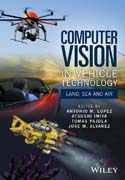
Computer Vision in Vehicle Technology: From Earth to Mars
López Corral, Antonio M.
Imiya, Atsushi
Pajdla, Tomas
Alvarez, Jose M.
Computer Vision in Vehicle Technology: Land, Sea & Air Antonio M. López, Universitat Autònoma de Barcelona, Spain Atsushi Imiya, Chiba University, Japan Tomas Pajdla, Czech Technical University, Prague Jose M. Alvarez, National Information Communications Technology Australia (NICTA), Canberra Research Lab, Australia A unified view of the use of computer vision technology for different types of vehicles Computer Vision in Vehicle Technology focuses on computer vision as on–board technology, bringing together fields of research where computer vision is progressively penetrating: the automotive sector, unmanned aerial and underwater vehicles. It also serves as a reference for researchers of current developments and challenges in areas of the application of computer vision, involving vehicles such as advanced driver assistance (pedestrian detection, lane departure warning, traffic sign recognition), autonomous driving and robot navigation (with visual simultaneous localization and mapping) or unmanned aerial vehicles (obstacle avoidance, landscape classification and mapping, fire risk assessment). The overall role of computer vision for the navigation of different vehicles, as well as technology to address on–board applications, is analysed. Key features: Presents the latest advances in the field of computer vision and vehicle technologies in a highly informative and understandable way, including the basic mathematics for each problem. Provides a comprehensive summary of the state of the art computer vision techniques in vehicles from the navigation and the addressable applications points of view. Offers a detailed description of the open challenges and business opportunities for the immediate future in the field of vision based vehicle technologies. This is essential reading for computer vision researchers, as well as engineers working in vehicle technologies, and students of computer vision. INDICE: 1 Computer Vision in Vehicles 3 .1.1 Adaptive Computer Vision for Vehicles 3 .1.2 Notation and Basic Definitions 7 .1.2.1 Images and Videos 7 .1.2.2 Cameras 9 .1.2.3 Optimisation 11 .1.3 Visual Tasks 12 .1.3.1 Distance 12 .1.3.2 Motion 15 .1.3.3 Object Detection and Tracking 18 .1.3.4 Semantic Segmentation 19 .1.4 Concluding Remarks 21 .2 Autonomous Driving 23 .2.1 Introduction 23 .2.2 Autonomous Driving in Cities 29 .2.2.1 Localization 32 .2.2.2 Stereo Vision based Perception in 3D 34 .2.2.3 Object Recognition 40 .2.3 Challenges 46 .2.3.1 Increasing Robustness 46 .2.3.2 Scene Labeling 47 .2.3.3 Intention Recognition 48 .2.4 Summary 49 .3 Computer Vision for MAVs 51 .3.1 Introduction 51 .3.2 System and sensors 53 .3.3 Ego–motion estimation 53 .3.3.1 State estimation using inertial and vision measurements 53 .3.3.2 MAV pose from monocular vision 57 .3.3.3 MAV pose from stereo vision 58 .3.3.4 MAV pose from optical flow measurements 60 .3.4 3D mapping 62 .3.5 Autonomous navigation 64 .3.6 Scene interpretation 66 .3.7 Concluding remarks 66 .4 Exploring the Seafloor with Underwater Robots 69 .4.1 Introduction 69 .4.2 Challenges of underwater imaging 70 .4.3 Online computer vision techniques 72 .4.3.1 Dehazing 72 .4.3.2 Visual Odometry 77 .4.3.3 SLAM 80 .4.3.4 Laser scanning 84 .4.4 Acoustic imaging techniques 85 .4.4.1 Image formation 85 .4.4.2 Online techniques for acoustic processing 88 .4.5 Concluding remarks 90 .5 Vision–based Advanced Driver Assistance Systems 95 .5.1 Introduction 95 .5.2 Forward Assistance 96 .5.2.1 Adaptive Cruise Control (ACC) and Forward Collision Avoidance .(FCA) 96 .5.2.2 Traffic Sign Recognition (TSR) 98 .5.2.3 Trafic Jam Assist (TJA) 99 .5.2.4 Vulnerable Road User Protection 100 .5.2.5 Intelligent Headlamp Control 103 .5.2.6 Enhanced Night Vision (Dynamic Light Spot) 104 .5.2.7 Intelligent Active Suspension 105 .5.3 Lateral Assistance 106 .5.3.1 Lane Departure Warning (LDW) and Lane Keeping System (LKS) 106 .5.3.2 Lane Change Assistance (LCA) 108 .5.3.3 Parking Assistance 109 .5.4 Inside Assistance 109 .5.4.1 Driver Monitoring and Drowsiness Detection 109 .5.5 Conclusions and Future Challenges 112 .5.5.1 Robustness 112 .5.5.2 Cost 113 .6 Application Challenges from a Bird s–Eye View 117 .6.1 Introduction to Micro Aerial Vehicles (MAVs) 117 .6.2 GPS–denied Navigation 118 .6.2.1 Autonomous Navigation with Range Sensors 119 .6.2.2 Autonomous Navigation with Vision Sensors 119 .6.2.3 SFLY: Swarm of Micro Flying Robots 120 .6.2.4 SVO, a visual–odometry algorithm for MAVs 121 .6.3 Applications and Challenges 122 .6.3.1 Applications 122 .6.3.2 Safety and Robustness 123 .6.4 Conclusions 125 .7 Application Challenges of Underwater Vision 127 .7.1 Introduction 127 .7.2 Offline computer vision techniques for underwater mapping and inspection 128 .7.2.1 2D mosaicing 128 .7.2.2 2.5D mapping 138 .7.2.3 3D mapping 140 .7.2.4 Machine learning for seafloor Classification 147 .7.3 Acoustic mapping techniques 149 .7.4 Concluding remarks 153 .8 Closing Notes 157 .References 159
- ISBN: 978-1-118-86807-2
- Editorial: Wiley–Blackwell
- Encuadernacion: Cartoné
- Páginas: 216
- Fecha Publicación: 30/12/2016
- Nº Volúmenes: 1
- Idioma: Inglés
